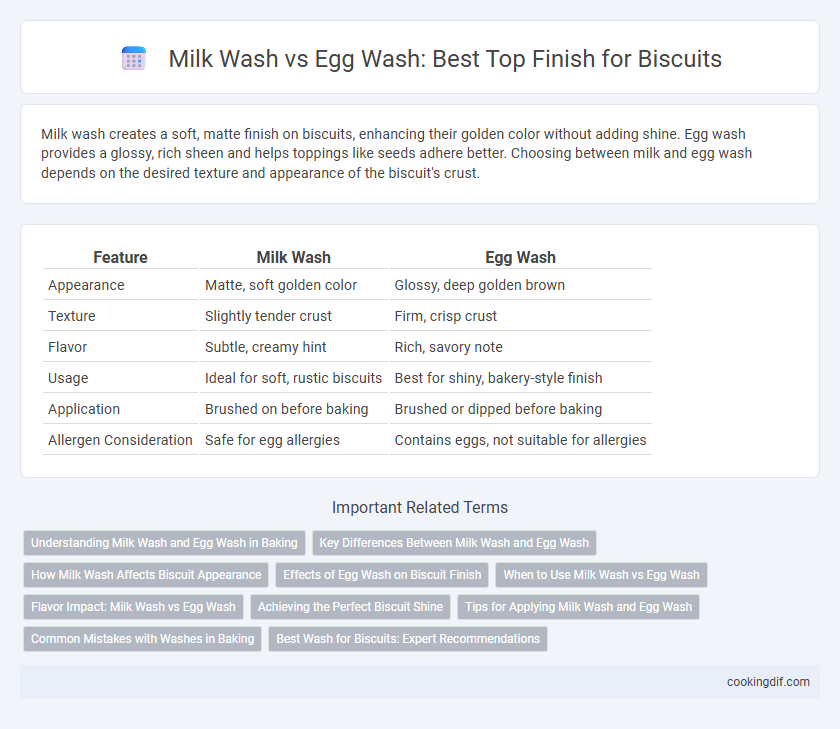Milk wash creates a soft, matte finish on biscuits, enhancing their golden color without adding shine. Egg wash provides a glossy, rich sheen and helps toppings like seeds adhere better. Choosing between milk and egg wash depends on the desired texture and appearance of the biscuit's crust.
Table of Comparison
| Feature | Milk Wash | Egg Wash |
|---|---|---|
| Appearance | Matte, soft golden color | Glossy, deep golden brown |
| Texture | Slightly tender crust | Firm, crisp crust |
| Flavor | Subtle, creamy hint | Rich, savory note |
| Usage | Ideal for soft, rustic biscuits | Best for shiny, bakery-style finish |
| Application | Brushed on before baking | Brushed or dipped before baking |
| Allergen Consideration | Safe for egg allergies | Contains eggs, not suitable for allergies |
Understanding Milk Wash and Egg Wash in Baking
Milk wash creates a soft, slightly glossy crust on biscuits by adding moisture and mild browning, enhancing texture and color without overpowering flavor. Egg wash, consisting of beaten egg sometimes mixed with water or milk, produces a shiny, golden, and crisp finish, offering a more pronounced sheen and deeper color. Choosing between milk wash and egg wash depends on the desired biscuit appearance and texture, with milk providing subtle sheen and soft crust, while egg delivers a vibrant, glossy surface.
Key Differences Between Milk Wash and Egg Wash
Milk wash provides a subtle sheen and slightly soft texture to biscuit tops, while egg wash creates a glossy, golden-brown finish with a firmer crust. Milk wash is primarily used for a delicate color and moisture retention, whereas egg wash enhances browning and adds a richer appearance. The choice between milk wash and egg wash depends on the desired biscuit texture and visual appeal.
How Milk Wash Affects Biscuit Appearance
Milk wash enhances biscuit appearance by creating a soft, matte finish with a subtle golden hue, boosting visual appeal without excessive shine. The natural sugars and proteins in milk gently caramelize during baking, promoting even browning and a tender crust texture. This method results in biscuits with an inviting, rustic look compared to the glossy, rich finish achieved by egg wash.
Effects of Egg Wash on Biscuit Finish
Egg wash creates a glossy, golden-brown finish on biscuits by promoting Maillard reaction and caramelization during baking. Its protein and fat content enhance crust texture, yielding a slightly crisp surface compared to milk wash. Using egg wash also improves adhesion of toppings like seeds or sugar, contributing to an appealing, professional appearance.
When to Use Milk Wash vs Egg Wash
Milk wash enhances biscuits by creating a soft, golden-brown crust ideal for tender, flaky textures, making it perfect for sweet or mild-flavored recipes. Egg wash produces a glossy, deep golden or brown finish with a slightly firmer crust, preferred for savory biscuits that require a visually appealing shine. Choose milk wash when aiming for a gentle color and soft finish, and opt for egg wash to achieve a bold, glossy appearance with added crust firmness.
Flavor Impact: Milk Wash vs Egg Wash
Milk wash imparts a subtle, creamy flavor and helps achieve a tender, slightly sweet crust on biscuits, enhancing their overall richness without overpowering the base taste. Egg wash creates a glossy, golden-brown finish with a richer, more savory flavor that complements the buttery biscuit dough, adding a slightly crisp texture to the surface. Choosing between milk and egg wash depends on whether a soft, milky sweetness or a bold, savory crust aligns better with the desired flavor profile of the biscuits.
Achieving the Perfect Biscuit Shine
Milk wash provides a gentle, matte finish that enhances the golden brown color of biscuits without adding gloss, making it ideal for a natural look. Egg wash creates a high-gloss, rich shine and promotes browning, producing a visually striking and appealing top crust. Selecting between milk wash and egg wash depends on the desired biscuit appearance and texture, with milk wash yielding a softer finish and egg wash delivering a crisp, glossy surface.
Tips for Applying Milk Wash and Egg Wash
For a golden and tender biscuit crust, apply milk wash using a pastry brush evenly before baking to ensure a soft, shiny finish without over-saturating the dough. When opting for egg wash, whisk one egg with a tablespoon of water or milk, then lightly brush on the biscuit surface to achieve a rich, glossy, and slightly crispy top; avoid pooling to prevent uneven browning. Use gentle, even strokes and bake biscuits immediately after applying the wash to maximize the visual and textural effects.
Common Mistakes with Washes in Baking
Milk wash often leads to a softer, duller biscuit crust, which can result from over-applying or using the wrong temperature of milk. Egg wash typically provides a glossy, golden finish but common mistakes include uneven application or using eggs without proper mixing, causing streaks or spotting. Both washes require careful brushing to avoid soggy dough or overly dark spots, impacting the biscuit's texture and appearance.
Best Wash for Biscuits: Expert Recommendations
Egg wash creates a golden, glossy finish that enhances the visual appeal and adds a subtle richness to biscuits, making it the preferred choice among bakers for a traditional look. Milk wash offers a softer color with a slightly matte finish, ideal for those seeking a gentler crust without additional flavor complexity. Experts recommend egg wash for flaky, tender biscuits where a shiny, appetizing surface is desired, while milk wash suits biscuits aiming for a delicate crispness and mild browning.
Milk Wash vs Egg Wash for top finish Infographic

 cookingdif.com
cookingdif.com